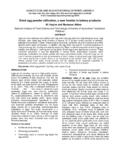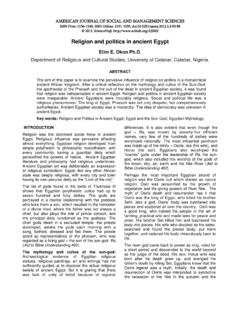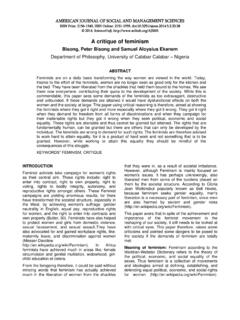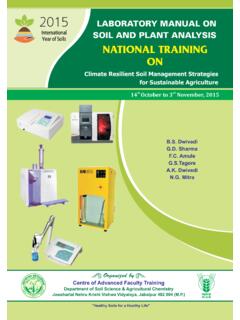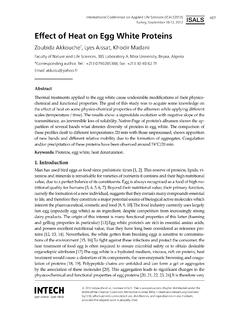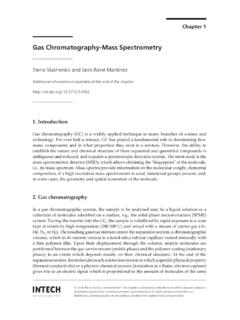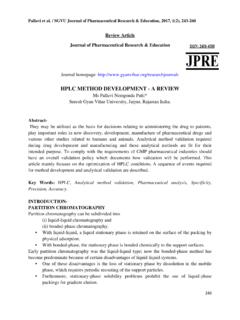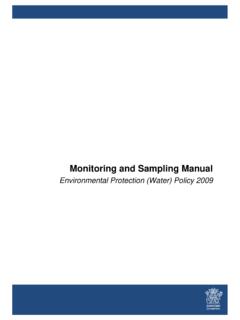Transcription of Production and quality evaluation of cocoa products (plain ...
1 AMERICAN JOURNAL OF FOOD AND NUTRITION. Print: ISSN 2157-0167, Online: ISSN 2157-1317, 2013, ScienceHu , Production and quality evaluation of cocoa products (plain cocoa powder and chocolate). *. Ndife Joel1, Bolaji Pius1, Atoyebi Deborah1 and 2 Umezuruike Chris. 1. Department of Food Technology, Kaduna Polytechnic, Nigeria. 2. Department of Food Science and Technology, Michael Okpara University of Agric., Umudike-Umuahia, Nigeria. *. Corresponding author. E-mail: ABSTRACT. Raw cocoa beans were used to produce cocoa powder and chocolate samples . The processing steps include fermentation, drying, roasting, milling, pressing and conching. The fermentation time varied from 1to 7days, represented as samples A, B, C, D, E, F and G respectively, in order to monitor the influence on the moisture content and cocoa products quality .
2 The reconstition-characteristics, chemical composition and sensory quality of the cocoa powder and chocolate samples were determined. The results show that the average moisture loss in the beans after roasting was The reconstition properties of cocoa powders show that the 3. dispersibility ranged from to , bulk density ranged from to and rehydration time ranged from 19 to 54 seconds. While the average proximate composition for cocoa powder and chocolate were: moisture ( and ), fat ( and ), protein ( and ), fibre ( and ), ash ( and ), carbohydrate ( and ) and energy ( Kcal) respectively. The organoleptic evaluation on the chocolate samples showed that there were significant differences (p< ) in the sensory attributes of colour, aroma, texture and taste. Sample GC derived from seven days fermented raw cocoa -beans was adjudged the best based on the overall acceptance.
3 Key words: cocoa , Nibs, Chocolate, Reconstitution properties, Sensory attributes. INTRODUCTION quantum of proteins, carbohydrates, fats, minerals and phytochemicals in the cocoa products and the cocoa beans are derived from the fruit of the plant corresponding digestibility coefficient (Belscak et al, Theobroma cacao L. In Nigeria, dry cocoa beans is 2009; Adeyeye et al, 2010; Lettieri-Barbato et al, majorly exported as a foreign exchange earner, while 2012). a small percentage of the cocoa beans serve as raw material for cocoa powder, cocoa butter and cocoa beans, as well as cocoa derived products , chocolate products (Adeyeye et al, 2010). also present a rich source of phytonutrients, cocoa as a food ingredient is fast becoming very particularly catechins and procyanidins (Lecumberri popular in the food and confection industry et al, 2007).
4 The total poly-phenol content of the bean worldwide. It is available in a wide variety of forms, is estimated to be 6-8% by weight of the dry bean colors and flavors and is used in numerous (Wollgast and Anklam, 2000). cocoa polyphenols applications (Borchers et al, 2000). A good quality have been reported in many studies as bioactive cocoa powder should be relatively free flowing, stable compounds, with antioxidant, antiradical and and uniform in colour and flavour, of good anticarcinogenic properties (Counet et al, microbiological quality , and easy to handle by the 2006;Othman et al, 2007; Belscak et al, 2009;. user (Vu et al, 2003). Moreover, a range of other Lettieri-Barbato et al, 2012). characteristics such as pH, fineness, fat content, wettability, solubility and dispersibility, define the cocoa powder is used in making beverages with powder and have an important impact on the end other ingredients such as milk and sugar while cocoa product for which the cocoa is used (De- Muijnck, butter is used for chocolate Production .)
5 Chocolate 2005). The nutritional quality of cocoa products are products are desired and eaten, due to their attractive determined largely by the chemical composition of flavours and appearances (Othman et al, 2007;. the cocoa powder, which is dependent on the Pimentel et al, 2010). The primary chocolate Am. J. Food. Nutr, 2013, 3(1): 31-38. categories are dark, milk and white (Afoakwa et al, mass were separated from each sample of cocoa 2007). The widely enjoyed chocolate-flavour, make it mass. The remaining cocoa mass samples were a favorite ingredient in bakery, ice cream, beverage, pressed using a hydraulic-press and muslin cloth in syrup manufacture and as a confection in itself order to extract the fat ( cocoa -butter). The dried (Lecumberri et al, 2007). pressed cake for each sample were ground and sieved to obtain desired size particles of cocoa Nowadays, consumers are more concerned with the powder and labeled AP, BP ,CP, DP, EP, FP and GP.
6 Nutritional status of foodstuffs and considering that respectively. cocoa powder and chocolate are extremely rich sources of many essential nutrients and phyto- The cocoa mass ( cocoa butter and nibs) were mixed chemicals that can contribute to a healthy diet with other ingredients of sugar, milk and nutmeg. The (Lecumberri et al, 2007; Ieggli et al, 2011) highlight cocoa -mass-mix for each sample was conched at 0. renewed interest in such products . 80 C for 45min, using a stone-mill to give velvet smoothness. Each of the samples was tempered by o The objectives of this research therefore, were to stirring and cooling to 45 C and was poured into produce cocoa products (plain cocoa powder and molds for subsequent hardening and shaping. They chocolate) from raw cocoa beans and to assess the were wrapped with aluminum foil and labeled as nutritional and sensory quality of the cocoa products samples AC, BC, CC, DC, EC, FC, and GC, after which o as well as the consumer overall acceptance.
7 They were stored in a freezer at -5 C, from where samples were taken for further analyses. MATERIALS AND METHODS. physico - chemical analysis : The chemical The fresh cocoa beans were obtained from a local composition of the cocoa powder and chocolate cocoa farm center in Akure, Ondo state, while, samples viz: pH, moisture, protein, fat, crude fiber ingredients such as; sugar, nut-meg and milk were and ash contents were determined by methods purchased from the central market, Kaduna in described by AOAC (1990). Carbohydrate was Nigeria. calculated by difference, and energy was calculated using Atwater conversion factors. The reconstition- Production of plain cocoa powder and chocolate: characteristics of the cocoa powder samples , such as Fresh cocoa pods were harvested ripe and opened to bulk density, dispersibility and rehydration in both hot extract the wet beans.
8 The wet beans were scooped water and cold water were carried out as described with table knife from the pod into the basket. The by Compaore et al, (2011). basket containing the beans were initially lined and covered with banana leaves. The wet beans with Sensory analysis : Sensory evaluation of the their pulps were allowed to ferment for 7 days. The chocolate samples were carried out by 25 panelists wet beans were labeled as samples A, B, C, D, E, F of judges, on a 9 point hedonic scale for different and G for each day of fermentation. The daily parameters such as colour, aroma, taste, texture and ambient temperatures and moisture contents of the overall acceptability as described by Iwe (2010). fermenting beans were observed and recorded. After which the fermented pulps and other extraneous Statistical analysis : The sensory evaluation data materials like sand-residues, chaffs, beans shell and was statistically analyzed using the analysis of hollow beans were manually removed and the beans variance (ANOVA) and the Duncan Multiple range were washed to remove the remnant mucilage.
9 The test with significance level at p< (Ihekoronye and fermented cocoa beans were dried in hot air oven at Ngoddy, 1985). 0. a temperature of 60 C for 23 hours for each day of fermentation and their moisture contents were RESULTS AND DISCUSSION. analyzed. The different fermented dried beans were 0. roasted at same temperature of 120 C for 65 min. Moisture content assessment of cocoa beans The roasted beans were cracked (kibbled) after The moisture contents of raw beans (unfermented), which the shells were separated from the roasted- dried beans (after fermentation), roasted beans and cotyledons by winnowing. Most of the Nibs (90%) for the final percentage moisture loss of cocoa beans are each sample were ground using a grinding machine, shown on table1. to give cocoa mass and the remainder (10%) was left for subsequent chocolate Production .
10 150g of cocoa 32. Am. J. Food. Nutr, 2013, 3(1): 31-38. The results show that fermentation time has some the moisture content of processed cocoa beans effect on the moisture content of the processed would fluctuate depending on the fermentation and cocoa beans. The average moisture contents in raw, drying conditions. Moisture is necessary for the dried and roasted beans were , and biochemical changes that may influence the sensory respectively. Asiedu (1989) had reported that and shelf quality of the cocoa products . RAW cocoa BEANS. FERMENTATION. DRYING. CLEANING. ROASTING. BREAKING AND WINNOWING. SHELL. GERM FREE NIB. MILLING. cocoa MASS. CHOCOLATE MANUFACTURE. FAT PRESSING Addition of Sugar Milk, Nutmeg and cocoa Butter PRESSED CAKE cocoa BUTTER MIXING. GRINDING CONCHING.

